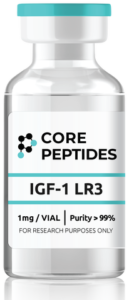This article provides a brief overview of peptide IGF-1 LR3. Furthermore, the purpose of the overview is to provide some helpful answers to frequently asked questions surrounding IGF-1 LR3 peptide.
The IGF-1 LR3 peptide review begins with what the peptide is and does, and then it briefly covers the IGF-1 LR3 benefits and side effects, as well as where the researcher can buy IGF-1 LR3 peptide.
What Is IGF-1 LR3 Peptide?
IGF-1 LR3 is a chemical naturally formed by the organism. IGF 1 Long R3 is a polypeptide amino acid.
Naturally, human growth hormone is turned into IGF 1 to begin getting rid of excess glucose throughout the body. The purpose of this peptide is to work the same way when administered on test subjects during experiments.
IGF-1 LR3 is just an extended analogue of IGF-1, and is actually a synthetic protein. The difference between this and the original IGF-1 is that, instead of a glutamic acid, LR3 contains arginine at the 3rd position of its amino sequence – hence R3.
It also has thirteen more amino acids at its N-terminus, making it much longer, for a combined total of eighty three aminos, compared to the seventy that comes with IGF-1 alone.
The potency of IGF 1 LR3 is about 3 times more than that of IGF-1 [ref 1], and it holds a significantly greater half-life – roughly twenty to thirty hours, compared to the original IGF-1, which has only about twelve to fifteen hours of half-life.
Difference Between IGF-1 LR3 vs LR2
Though molecularly and structurally alike, IGF-1 LR3 should not be confused with LR2.
The main difference between the two is that IGF LR3 is primarily found in adult organisms, while LR2 presents itself more in younger organisms whose bodily systems are still undergoing development. This is one way to understand why IGF-1 significantly affects muscle tissue growth and repair.
The IGF 1 LR3 peptide was developed for long term research to closely study its potential ability to aid in preventing the deactivation of binding proteins within the blood [ref 2].
IGF 1 LR3 Benefits
IGF-1 LR3 has presented multiple benefits in various studies. Its primary advantages include its potential ability to burn fat (through increased lipolysis, aiding in weight loss) and build muscle (by promoting protein synthesis and muscle recovery).
Does IGF 1 LR3 Burn Fat?
IGF-1 LR 3 boosts energy metabolism efficiency by getting cells to become more sensitive to insulin, while at the same time elevating the fat catabolic rate, in other words resulting in fat loss. This is a metabolic process through which energy is released as fat is broken down into smaller, more easily manageable compounds.
This is all done to fuel important cellular processes. It boosts the metabolism of fat in muscle tissue, while also up-regulating protein synthesis in muscle cells (individually) and preserving glucose at the same time.
The final result, then, is muscle growth due to increases in the size of the cell. Atop the muscle gains, studies have also presented the peptide’s ability to lower the body’s general fat content.
Does IGF 1 LR3 Build Muscle?
One study aimed to investigate IGF-1 LR3 peptide’s effects on the metabolism of protein. The non-human animal subjects used in this study were underfed on purpose, so that they lose weight.
The subjects were divided into a test group (who were administered the peptide intravenously) and the control group (who did not receive the substance). The results found that the animals in the test group were able to preserve protein in both their skeletal muscles and the body as a whole.
Recent studies have presented IGF-1’s role as a moderator of GH effects. Therefore, it is implied that whatever IGF-1 does affects the majority of the body’s cells.
Again, IGF-1 is produced at its highest levels usually throughout puberty, which is why the young organism undergoing this process experiences both significant muscle growth and a growth spurt in height.
How Does IGF-1 LR 3 Work?
IGF-1 LR3 is a significant (hormonal) moderator of statural growth. Usually, in the liver as well as in other tissues, growth hormone sticks to its receptor and promotes IGF-1 secretion and synthesis.
In particular tissues, the IGF (type 1) receptor that corresponds to the insulin receptor is activated by IGF-1 LR3 which causes intracellular communication which then promotes various processes resulting in the growth of the organism’s stature.
The metabolic actions of IGF-1 LR3 are aimed partially at promoting the uptake of fatty acids, amino acids, and glucose so that developing tissues are supported by their metabolism.
IGF 1 LR3 Side Effects
With all research substances, there comes the possibility of adverse effects. Particularly in the case of IGF-1 LR3 side effects, they are similar to those of human growth hormone (HGH) [ref 3]:
- Drop in blood sugar
- Overgrowth of body tissue
- Skin sensitivity at injection site
- Liver damage
These side effects, however, are much less likely to be experienced if the substance is responsibly administered by the researcher on the test subjects.
Buy IGF-1 LR3
Researchers can find IGF-1 LR3 for sale online, but it’s best to use a trusted source.
You can buy IGF-1 LR3 and other high quality peptides and peptide blends for research by visiting the Core Peptides online store.
References:
- Tomas M, et al. “Superior potency of infused IGF-I analogues which bind poorly to IGF-binding proteins is maintained when administered by injection.” 1996.
- Oliver T., et al. “The local expression and abundance of insulin-like growth factor (IGF) binding proteins in skeletal muscle are regulated by age and gender but not local IGF-I in vivo.” 2005
- Anderson, J., et al. “Use of growth hormone, IGF-I, and insulin for anabolic purpose: Pharmacological basis, methods of detection, and adverse effects.” 2018.
NOTE: The information found on this website and within this article is intended for educational or informational purposes only. Some or all of the content in these articles are not substantiated by a medical professional and may be based on the opinions of the writer who may not be a medical or accredited professional. Not intended for personal use. Please review our Terms and Conditions.

